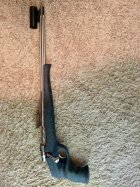I have an XP-100 in 7mm BR and am starting to prep some unfired Remington 7mm BR brass for it.
From what I've read, it seems like the chamber necks on the XP-100's were .309" and most competitors turned the necks on the brass down to .010", leaving zero neck thickness variation. Are both of these correct?
Remington ammo fired from my XP-100 gives brass with necks at ~.3095" after a day or so, suggesting a chamber neck at ~.3105", or maybe .310", instead of .309".
And a .010" neck thickness would give a ~.2835+2(.01)=~.3035"loaded diameter, and thus a relatively large .309-.3035= .0055" diametrical interference (clearance) with the chamber (or ~.0065-.0070" in my case), vs a diametrical interference of ~.309-(.2835+2(~.0118))=~.0019 with no neck turning (or ~.0029-.0034" in my case), based on the 55 cases measured.
This seems to suggest that there is no tradeoff between the neck thickness variation and diametrical interference in this particular situation. Removing ALL of the neck thickness variation is the optimum thing to do. Is that correct?
The neck thickness variation on the Remington brass IS pretty large, e.g. averaging a thickness range of ~.0023", but a decent part of that could be skimmed away while keeping the diametrical interference closer to .004".
Perhaps the newer Peterson 7mm BR brass with thicker necks would be one answer. But what people did back in the day with the Remington brass might be sufficient for my purposes.
Thanks for any help!
From what I've read, it seems like the chamber necks on the XP-100's were .309" and most competitors turned the necks on the brass down to .010", leaving zero neck thickness variation. Are both of these correct?
Remington ammo fired from my XP-100 gives brass with necks at ~.3095" after a day or so, suggesting a chamber neck at ~.3105", or maybe .310", instead of .309".
And a .010" neck thickness would give a ~.2835+2(.01)=~.3035"loaded diameter, and thus a relatively large .309-.3035= .0055" diametrical interference (clearance) with the chamber (or ~.0065-.0070" in my case), vs a diametrical interference of ~.309-(.2835+2(~.0118))=~.0019 with no neck turning (or ~.0029-.0034" in my case), based on the 55 cases measured.
This seems to suggest that there is no tradeoff between the neck thickness variation and diametrical interference in this particular situation. Removing ALL of the neck thickness variation is the optimum thing to do. Is that correct?
The neck thickness variation on the Remington brass IS pretty large, e.g. averaging a thickness range of ~.0023", but a decent part of that could be skimmed away while keeping the diametrical interference closer to .004".
Perhaps the newer Peterson 7mm BR brass with thicker necks would be one answer. But what people did back in the day with the Remington brass might be sufficient for my purposes.
Thanks for any help!











